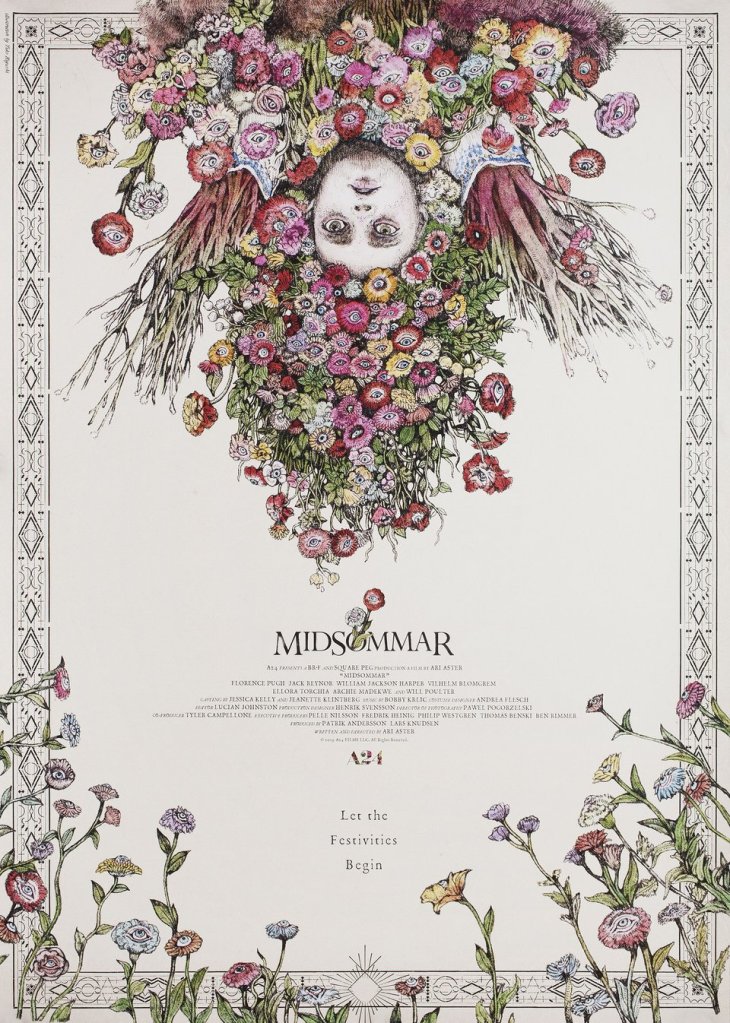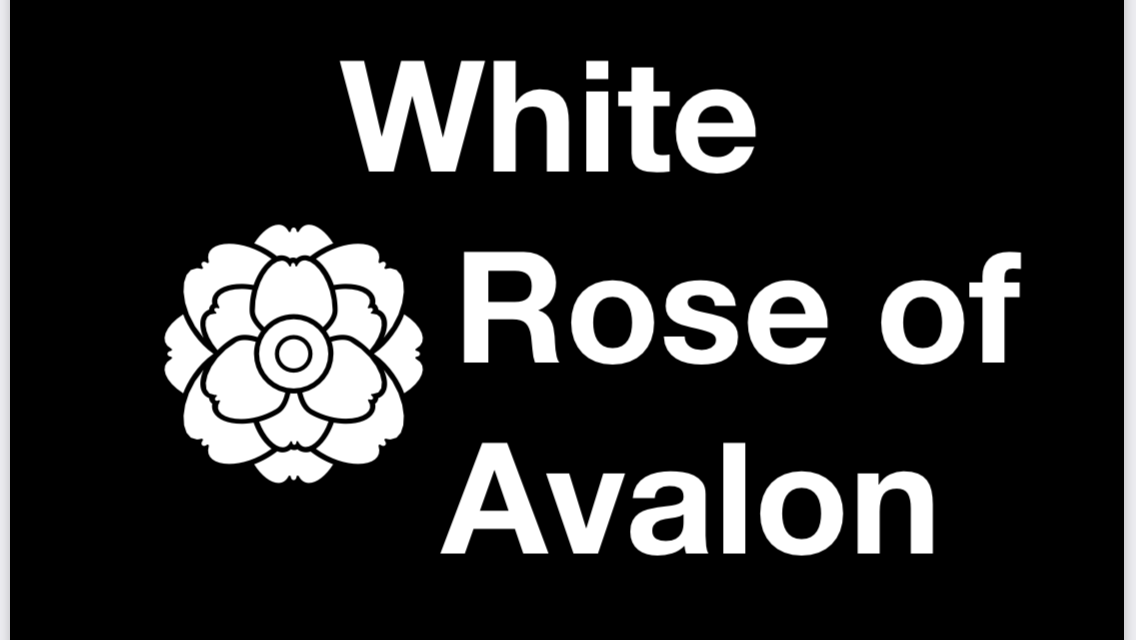
Welcome back to White Rose of Avalon my Darlings. Today’s post is a Midsummer Monday Magical Media Analysis of the amazing Ari Aster horror film Midommar! How perfect it is that this post will be released on June 24, which is St. John’s Day, and has been traditionally part of celebrations that have linked Pagan-originated Folk customs with the Catholic Saint John the Baptist, with the celebration beginning on the evening of June 23 (St. John’s Eve) and running through the next day. When Dani and her friends enter the Harga, it is clearly seen that they are walking through large patches of St. John’s Wort, which gets its common name because it is known to bloom around the feast day of St. John. This is the most solsticey of all plants, being picked at Midsummer and used at Midwinter to combat symptoms associated with seasonal affective disorder! Ari Aster, the writer and director has made it very clear that this is both a Folk Horror film and a breakup film, essentially telling the tale of the downfall of a co-dependant and toxic couple. So this is a film of grief, and clinging to that which you know even if it is toxic, as much as it is one of the best Folk Horror films since the original Wicker Man! Now, let’s get deeper into the analysis. I will be analyzing several of the film’s uses of Folk Magick in their own sections below.
THE NUMBER NINE
~From the very beginning of the film we are shown the number nine over and over. First, we learn that the festival takes place over nine days, when they take the mushrooms they realize the sun is still out at nine at night, the Great Feast is said to only be held every ninety years, and there are nine human lives sacrificed for said Great Feast! The number nine is the number of completion, the number of enchantment, and the number of perfection. Like everything in this Folk Horror Film, the energy of the number nine is used in a perverted way to emphasize how horrific and unacceptable the behavior of the Harga is, they are a cult and we as viewers are not meant to want to join them! So for them, the nines are about completing cycles and keeping their cult in line through their own form of justice.
RUNES
~Runes are used heavily throughout the film, with Pelle explaining that it is tradition to carve runes and sleep with them under your pillow to dream about their powers when they first reach the Harga. At the first feast, we see that the table is set up in the shape of the rune Othala, which is associated with the Goddess, property, home, and plenty, but the shape is upside down, making it a murkstave and inverting the meanings, another show of the perverse nature of this cult. Later, at the Sacrifice ritual, a stone shows several runes. They include Algiz, meaning protection as a murkstave again (so inverting its meaning), Raido which means journey, Tiwaz, which means justice honor, and leadership, and Nauthiz, which means need, hardship, and delays! Together these runes are telling the story of the horror that is about to unfold in the terrors of the Sacrifice Ritual.
EMPATHY
~Empathy is shown to be taken on quite viscerally in the Harga, with everyone emoting together during rough times, and drawing in Dani who is going through so much trauma after the loss of her family. Yet again, this Empathy has a dark and unsettling energy, as it is something that the Harga does to lure in new members to make sure that they have fresh blood to infuse their cult with! Even the most comforting of magickal and spiritual practices is made horrifying in this film.
SEASONS OF HUMAN LIFE & SACRIFICE
~The Sacrifice Ritual is said by the Harga to be positive as it is a choice to end the cycle and recycle life so that the old people of the community do not hold the whole back. This has to do with their philosophy of seeing human life in terms of the seasons. Spring is from birth to eighteen years old, Summer from eighteen to thirty-six years old, Autumn from thirty-six to fifty-four years old, and Winter from fifty-four to seventy-two. At seventy-two they make the Sacrifice to make sure they do not hold back the younger members of the Harga. This is a very extreme and unsettling take on looking at life in terms of seasons, which is certainly a large part of many magickal traditions, as working with the phases of life through magick is common! So many people discuss the Maiden, Mother, and Crone when discussing the Triple Goddess, and others like to state a fourth energy when describing the phases of women’s lives, like Maiden, Lover, Mother, and Crone; or Maiden, Mother, Queen, and Crone! Once again, the film seeks to invert something beautiful into something awful due to the controlling nature of the cult. This Sacrifice is balanced out with the Harga being very upset when one of the group, Mark, pisses on a Tree they believe holds the spirits of the ancestors. This is one time the veneration of nature seems quite honest, but that certainly does not last long, as Mark is killed for this offense!
LOVE SPELL
~Ah, the infamous love spell, and one of the reasons this film is so controversial! It all begins with a Love Rune placed underneath Christian’s bed. Then Christian is drugged with a love potion, which includes menstrual blood in his drink and pubic hair in his food. These things are rooted in old Folk Magick traditions, and yes they are upsetting, and this is why Love Spells are considered curses in many ancient beliefs! To take the will of another away is beyond reprehensible and can come at great cost. That is why Love Spells are best focused on Self-Love, in my opinion, or done with permission of a partner you already have! No matter how badly Christian treated Dani, no one deserves to be violated after having a Love Spell cast upon them, and that is exactly what happens in the film! He is raped for the purposes of a fertility ritual, and Dani sees it, but thinks he has cheated on her, which is why she is prevailed upon to sacrifice Christian in the fire after being crowned May Queen!
MAY QUEEN
~That serves as the ideal lead-in for my final major analysis point, Dani as May Queen! Pelle explained to Dani early on in the film that each year as part of the Midsummer festivities a May Queen is crowned after a dance competition, which we learn includes a May Pole covered in flowers, which makes sense for a May Queen. However, this aspect has a bit of uncanny valley energy for actual Pagans, Polytheists, and Magickal Practitioners, as May Queens are associated with Beltane festivals, as the name suggests, not Midsummer ones! I tend to think, like everything else that is so perfectly placed into this narrative, the use of the May Queen is a sign of the perversion of the beauty of Pagan Folk Traditions, for the use of this cult. It is meant to be unsettling, with Dani winning and randomly being able to speak Swedish. Then Dani literally turned into a mound of Flowers, which incidentally I read as a reference to my beloved Blodeuwedd who is the Welsh Faery Queen and May Queen literally made of Flowers! The May Queen is a symbol of fertility and abundance, which has come into full bloom by Midsummer, but magickally the energy is different than it is at Beltane, as each of the Wheel of the Year holidays has its own energy. Dani’s being crowned May Queen is not a triumph, but instead, it is a culmination of her indoctrination into the Harga cult, which lends to the absolute terror of the film, for she has not escaped but instead become a murderer who took joy in seeing her boyfriend die! This is the absolute inversion of the energy and utter radiance that the May Queen holds, which I find very unsettling, especially as someone so deeply in tune with Faery Queens in general and May Queens in particular!
MISCELLANEOUS
~These are the several things that I wanted to mention, but not go into too much detail about, hence their inclusion in this section!
BALANCE BETWEEN SOLSTICES
~The film clearly begins in Winter when Dani’s sister kills herself and their parents, when not stated exactly in the film, I think it is safe to say this happened around the Winter Solstice, bringing a nice alignment between the energies of the two Solstices full circle!
MUSHROOMS
~Dani and the boys take mushrooms and have quite an interesting trip, which for Dani included seeing grass grow on her hand, a possible nod to her transformation into the May Queen made of flowers at the end, and a panic attack about her family. Mushrooms are linked to the Fae Realms, often being markers of Faery Circles, and the Fae are very associated with Midsummer!
DANI’S BIRTHDAY~GEMINI~CANCER
~Dani’s birthday occurs on the day they reach the Harga, which only Pelle (who brought them there to meet his family) remembers, giving her a drawing of her as May Queen, again prophetic foreshadowing. Dani being born so close to the Summer Solstice would make her either a Gemini or Cancer depending on her exact birthday. Her sister’s BiPolar Disorder can be seen as linked to the duality of Gemini, and Dani’s own emotional vulnerability connects to the watery nature of Cancer, so either way, I think this was very intentional!
DISRESPECT WHEN RESEARCHING FOLK CUSTOMS
~Josh, one of Christian’s friends, is working on his dissertation on Midsummer traditions, and he is very pushy about wanting to write about the Harga. Pelle feels uncomfortable, but relents in deciding to approach the Elders and ask for Josh, and eventually Christian (who had decided to also use the Harga for his dissertation), to be able to interview people. Josh gets himself killed by disrespecting traditions and trying to steal a sacred text! This is yet again an extreme perversion of how a sacred text would be treated (as it is written by a purposefully inbred boy, in their traditions).
LOST AND FOUND FAMILY/PERVERSION OF FAMILY
~Both Dani and Pelle have lost their families, with Pelle being raised by the Harga and Dani being alone, except for Christian who wants to end the relationship. The Harga accepts Dani as a found family, but their cult nature is a perversion of family life, especially when we see the horror of their incest to create a prophetic child!
~I hope you have enjoyed this analysis of Midsommar, which I think may be my longest Magical Media Analysis yet. What is your favorite use of Folk Magick in the film? Let me know your thoughts in the comments below!
Note on Image: The image at the top of the post is a gorgeous poster for the Japanese release of the film! I found the image on https://posteritati.com/poster/49719/midsommar-original-2019-japanese-b1-movie-poster.
LINK TO AVALONIAN ROSE FAERY MYSTERIES PATREON: https://patreon.com/AvalonianRoseFaeryMysteries?utm_medium=unknown&utm_source=join_link&utm_campaign=creatorshare_creator&utm_content=copyLink
Tarot Note: I have a page offering tarot and oracle readings for those interested in these services! I am very happy to be offering these readings to my treasured readers at White Rose of Avalon! Link to page: https://whiteroseofavalon.life/tarot-and-oracle-readings/
Further Watching/Reading
- Midsommar (2019)
- Northern Mysteries and Magick: Runes & Feminine Powers by Freya Aswynn
- The Mabinogion translated by Sioned Davies
